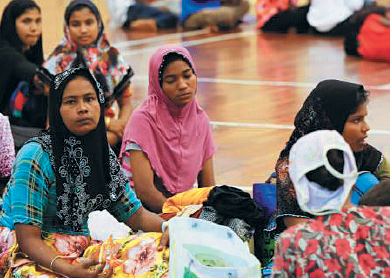
“IS there light at the end of the tunnel for anybody taking this path” ... that was the only question on my mind during the arduous journey on the trail from Kampung Syed Omar in Perlis used by illegal immigrants to cross into Malaysia from Thailand.
For a novice jungle trekker like me, the 3km distance appeared like 10km due to the hilly terrain, narrow uneven path covered with stones, leaves and broken branches, and not to mention the annoying insects and mosquitoes.
The locals guided me through the trail over the hill that cuts across the Malaysia-Thai border so I could get to see how difficult or easy it was to get into the country.
The same trail was among the popular ones for smugglers and human traffickers due to the unfenced 4km stretch that passes through Malaysia-Thailand forest reserve. It is said to be the fastest way to enter Malaysia.
Though my feet were aching, I continued with the challenging path taken by the illegal immigrants to the country. I wondered how the Rohingya and Bangladeshi, adults and children, would have crossed the trail barefoot and with tattered clothes, when I found it difficult to continue despite being properly attired and with a proper pair of shoes.
Besides the winding route over the hill, I had to cut through the tall grass and bushes and walk along a narrow ledge where a wrong step means one ends up in the ravine below.
The locals told me that many of the immigrants could have fallen into the ravine below as they trekked the jungle at night to avoid being spotted by the security forces or villagers.
Immigrants appeared in pathetic condition
When the villagers were asked whether they came across the immigrants who had used the trail, they nodded their head. Many have bumped into them, including women and children, in the foothills where the village is situated, in pathetic condition.
The villagers said the immigrants appeared skinny, barefoot, wearing tattered clothes and too weak to move.
A villager who only wanted to be known as Pak Tam related how he heard the voices of children when he went into the jungle to check on his durian orchard twice a week, but on realising his presence they went into hiding.
“There was a time when I heard the cries of a child close by but could not locate the child. Many of the villagers have come across these people with some even feeding them,” he added.
Kampung Syed Omar, located in Bintong, is about 10 minutes’ drive from Kangar town while the distance from the village to the Thai border was about 3km.
Villagers took pity on the immigrants
Kampung Syed Omar Village Development and Security Committee chairman Nor Mahizan Kasim said no one had ever imagined that there were illegal camp sites near their place holding the immigrants.
“Three years ago I came across 10 of them running helter-skelter, the fear on their face was obvious and they were so thin. It looked like they had not eaten for months and I felt so sad for them.
“I took pity of them and provided them with water to drink and papayas to eat ... they grabbed the fruit and gulped it together with the skin. I was so sad to see their fate. While we have poor people here too, their condition is not as bad as theirs,” he said.
According to Nor Mahizan, the immigrants did not understand Malay and only communicated through sign language and they were handed over to the anti-smuggling unit (UPP).
“We cannot provide them shelter regardless of their pathetic condition because we do not know their background and we may end up endangering ourselves by doing so. We only provide food and water before handing them over to UPP,” he explained.
Curse of human trafficking
These immigrants, mostly Rohingya and Bangladeshis, are victims of human trafficking — they were taken from Myanmar and Bangladesh to Thailand using the sea route and then to Malaysia over land across the Malaysia-Thai border.
The Kampung Syed Omar trail promised the Rohingya and Bangladeshis employment opportunities and a better life in Malaysia. The Rohingya are literally stateless as Myanmar does not accept them as their citizens while the Bangladeshis suffered from severe poverty.
Due to the hardships back home, they risked their lives to get to Malaysia by paying hefty sums to human trafficking agents who in turn hold them for ransom and subject them to torture. It is worse than slavery, with many of those dreaming of making it to Malaysia dying along the trail or at the camps where they were held for ransom. — Bernama
This article first appeared in The Edge Financial Daily, on June 11, 2015.